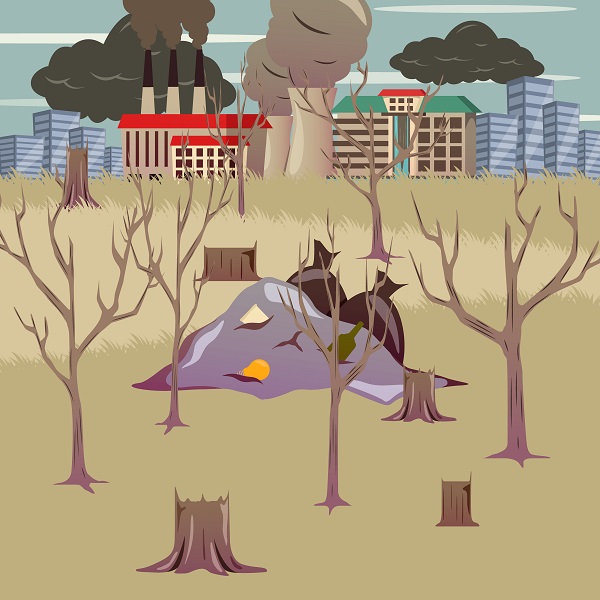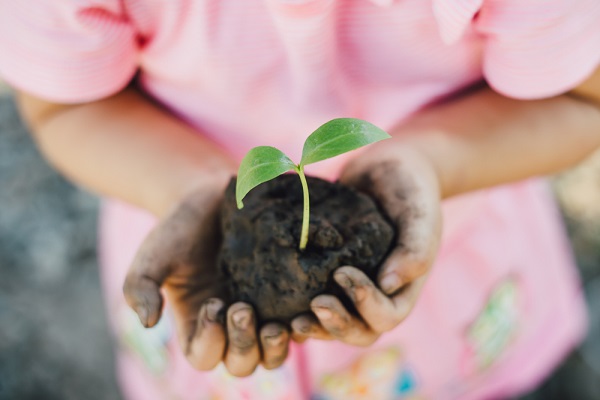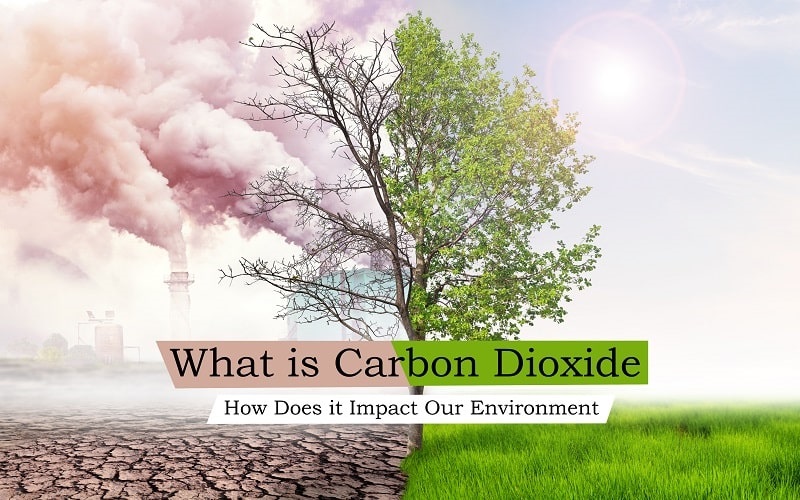What is carbon dioxide and how does it contribute to the damage of our environment? Read how increased levels of CO2 play a part in climate change.
Even while major natural disasters happen all over the globe, many people are debating the validity of climate change. The research from scientists proves that hurricanes, earthquakes, tornadoes, and other events are worse than they’ve ever been, and each summer seems to break heat records.
The primary cause for the change in climate is the existence of an abundance of carbon dioxide in the environment. To understand how this substance affects the environment, you need to know what it is and how it causes harm.
What is Carbon Dioxide?
Carbon dioxide, written as CO2, is a natural gas consisting of one carbon atom and two oxygen atoms. Everything on Earth is carbon-based, including humans, so it is a part of every natural process, including photosynthesis. Photosynthesis helps create carbohydrates or the foods that animals and humans eat, and humans expel CO2 from their bodies.
When humans digest the food they eat, the nutrients turn into energy for the body via oxygen. The byproduct of this process is CO2 , which is sent to the lungs for removal during exhalations. That is an autonomic process that repeats itself thousands of times a day.
During photosynthesis, plants use the water from the ground and carbon from the air to make and release oxygen. The sunlight provides the plants with energy to generate food and plants exhale the byproduct CO.
Due to commercial deforestation in the Amazon, the world’s largest rainforest, and other forests around the world, significantly fewer trees are available to produce oxygen for all living things, and rain to cool the Earth. The absence of trees and plants leaves the world hotter because there is less rain to keep the trees and plants cool.
Also, leave pores, or stomata, that produce oxygen start shrink shrinking because the plants are too hot.
As less evapotranspiration occurs, there is less rainfall. Also, with more CO2 in the atmosphere, it traps more heat, which causes the Earth to get hotter, plants to die, and less food is available to animals.
Man-Made Carbon Dioxide

Along with natural sources of CO2, man-made processes also create it. The main human contributions to the amount of carbon dioxide in the atmosphere are the burning of fossil fuels like coal, oil, and gas. Although fewer households use coal to generate heat, many companies that produce electricity using it to power their plants.
The emissions from air conditioners that keep people cool or help keep food fresh or frozen also
produce this gas that goes up into the atmosphere. Cars, trucks, trains, and airplanes also produce carbon dioxide that also is released into the air.
Carbon dioxide is responsible for about three-quarters of the greenhouse gases that affect the
environment by trapping heat and over warming the Earth. Along with the commercial destruction of millions of acres of trees, and removing the other vegetation around them, less rain is available to help water the remaining plants and repeat the photosynthesis process.
How CO2 Affects Weather
The devastation left behind after stronger more frequent hurricanes, fires, tsunamis, and earthquakes not only leads to loss of life but billions of dollars in the destruction of property and infrastructure. Climate change has led to the cause of a hotter Earth, which also means water oceans.
Stronger Hurricanes
When warmer ocean water near land masses meets cooler waters that are miles away from any land, they form tropical storms that can generate hurricanes. The high winds and flooding cause homes, businesses, boats, and other property to be lost in the destruction.
In the 2000s, hurricanes have been getting much stronger and more frequent around the world. In 2005, Hurricane Katrina became the most expensive hurricane in United States history, costing around $300 billion in losses. Over 1,800 people lost their lives.
Also, that same year, Hurricane Stan hit Mexico and Central America and cost over 1,600 people their lives. Then, Hurricane Wilma hit Mexico soon afterward and stayed over Cancun for approximately 60 hours. The flooding from these storms not only affects the areas hit by the initial impact of the hurricane but rainfall from their affects places hundreds of miles away.
More Frequent Tornadoes
The same effect that warmer waters have in the ocean also influences winds over land. The warmer air from the coast results in more frequent tornadoes as it meets cooler air coming down from Canada. The landmasses under this meeting of the winds then must contend with tornadoes that can flatten everything in sight.
Tornadoes are also stronger, with some as strong as EF4 and EF5. In 2007, an EF5 tornado landed in the town of Greensburg, Kansas flattening about 95 percent of the buildings in the area. In February of 2008, an outbreak of tornadoes left 58 people dead in the southern states. Also, in May of 2009, cyclone Aila hit Bangladesh and West Bengal in India and kills 155 people.
Approximately 500,000 are left homeless in the aftermath of the storm. A warmer world also has effects on forest fires as well.
Frequent Forest Fires
With less rain in the atmosphere, the earth is drier, and wildfires often break out when lightning strikes dry timber, or someone drives by and flicks a lit cigarette out of their car. Fires now burn over twice the area they did in 1970 and the season can last up to 78 days longer.
Although most fires have man-made causes, whether they are accidentally or purposely set, the drier conditions from climate change make them spread further and make them harder to put out. Millions of dollars in property are lost, and lives are put at risk during wildfires. Also, wildlife and farm animals lose their homes and die in them as well.
In 2015, 10 million acres were burned in the western US by wildfires, half of them in only Alaska. This figure topped the nine million acres that burned in 2012, in which the state of Colorado had their most destructive fires ever on record, the Waldo Canyon and High Park fire.
The aftermath of these fires can be destructive as well because when it rains, there is no vegetation left to prevent mudslides from coming down mountains and hills and destroying everything. Homes, businesses, cars, trucks, and anything else can get covered in mud or ruined.
Preventing Climate Change

Now that you know what carbon dioxide is and that it makes up the majority of greenhouse gases, the focus on reducing them is usually on ways to reduce its man-made production. One way to accomplish this is to encourage people to cut their carbon footprints by driving their cars less frequently and turning to alternative means of transportation for commuting to work or for leisurely activities.
Many states are encouraging carpooling with co-workers by offering free rides over bridges and on turnpikes for vehicles with more than three passengers. Also, transit companies encourage commuters to take a bus, subway, or train to work, especially in large cities like New York or Los Angeles, to cut emissions.
Planting Trees and Create Green Spaces
Many environmental organizations and businesses plant trees on Arbor Day or when people purchase merchandise. The apparel company tentree plants 10 trees for every item bought from their website. Also, larger cities encourage architects and other designers to create green spaces in their urban areas and gardens on rooftops and balconies on multistory buildings.
These green spaces not only provide people with places to take their children, enjoy a walk, or plant gardens, but they counteract the warming effects of the concrete jungle. The greenery helps cool the buildings and cities, saving energy and reducing the greenhouse effect.
Incentivizing Clean Energy
To encourage home and business owners to turn away from fossil fuels and use alternative energy sources, many countries like Australia offer incentives for converting to solar energy. By providing tax deductions and other incentives, they get more people using solar power to light, cool, and heat their homes or commercial buildings.
Many more states in the US are also converting to clean energy sources like solar, wind, or water power. Many energy companies are creating solar and wind farms to harness the energy and turn it into electrical power for their customers. People who power their homes with solar energy can sell back the energy they don’t need to their local power company.
Changing How People Drive
Oil isn’t available in infinite supplies so, as wells dry up, there is less fuel for transportation needs. Car manufacturers around the world are resolving this issue by designing vehicles that run on gas and electricity or solely electricity.
More electric charging stations are appearing at gas stations or stores offering gas for vehicles to help make electric cars easier to recharge. Also, many companies selling biofuels are increasing, and they are selling them at stations too.
Ethanol, which is made from corn in the US or sugarcane in Brazil, is more available around the world. Other forms of biofuels include biodiesel, which results from using vegetable oil and other animal fats, and biogas from animal manure and other organic materials.
People can participate in helping to cool down the Earth by cutting back on their emissions by knowing the answer to the question, “what is carbon dioxide?”
-
Some people have proposed carbon sequestration as a solution to global climate change. But what…
-
The moisture analysis of raw materials using the best moisture meters is crucial to any…
-
Inspecting hard-to-reach places is almost impossible until you have the best borescope with you. It…





